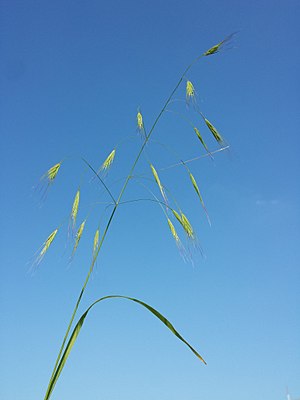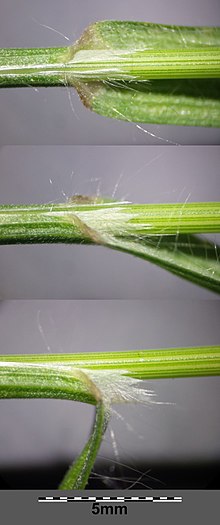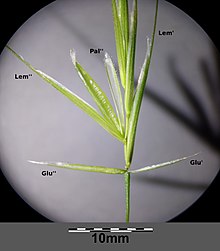Pigeon brach
| Pigeon brach | ||||||||||||
|---|---|---|---|---|---|---|---|---|---|---|---|---|

Bromus sterilis ( Bromus sterilis ) |
||||||||||||
| Systematics | ||||||||||||
|
||||||||||||
| Scientific name | ||||||||||||
| Bromus sterilis | ||||||||||||
| L. |
The pigeon Trespe ( Bromus sterilis ) is a species of the sweet grass family (Poaceae). It was introduced by humans to Central Europe before 1492 and is therefore considered an archaeophyte there . It can survive the winter as a hemicryptophyte or as a seed ( therophyte ).
features
The pigeon Trespe is an annual or annual wintering, herbaceous plant that reaches heights of about 30 to 60 centimeters and has bare stalks . Flowering time is from June to August.
The loose and drooping panicle is about 10 to 15 cm long. The lower panicle branches are usually as long as spikelets that are not compressed. Rough, flexible branches stick out from it everywhere. The husks are always rounded on the back. The 15 to 30 mm long awn is almost twice as long as the strongly- veined lemma . The spikelets are 4 to 6 cm long with the awn and elongated towards the tip. The lemma is 13 to 23 mm long. The lower glume is one-nerved, the upper three-nerved. The plant has finely toothed ligules.
The number of chromosomes is 2n = 14 or 28.
Systematics and naming
The pigeon Trespe was first published in 1753 by Carl von Linné in Species Plantarum . Together with similar species, the pigeon Trespe is often separated from the genus Bromus and is then called Anisantha sterilis (L.) Nevski .
"Bromus" is the name for an oat-like plant. “Sterilis” = “deaf, sterile” must be interpreted very freely as “not oats”. In contrast to the seed oats , the pigeon Trespe cannot be used as a grain, but of course it is not sterile.
Occurrence
The distribution area extends from Europe and the Mediterranean to Central Asia. The pigeon Trespe is widespread in the weed border of dry roads, in gappy, slightly shaded meadows, on rubble sites, on walls or embankments, also in clover fields and vineyards.
It prefers loose and therefore mostly sandy or stony loamy soil that should be moderately rich in nitrogen. It can withstand dehydration and can also live on encrusted stone rubble or in cracks in walls. She loves warm locations. In the Allgäu Alps, it does not exceed the limit of 800 meters above sea level.
According to Ellenberg , it is a semi-light plant, distributed sub-oceanic and prefers locations that are moderately nitrogenous. It thrives in societies of the associations Sisymbrion or Fumario-Euphorbion.
As a result of close crop rotations, early sowing dates and tillage without a plow, the pigeon Trespe is increasingly spreading on cultivated areas, especially in winter grain. There, their occurrence leads to yield losses, difficult harvesting conditions and quality losses.
ecology
The pelted seeds are spread by animals ( epizoochory ). The rough awns stick to the fur.
literature
- Dietmar Aichele, Heinz-Werner Schwegler: The flowering plants of Central Europe . 2nd Edition. tape 5 : Swan flowers to duckweed plants . Franckh-Kosmos, Stuttgart 2000, ISBN 3-440-08048-X .
- Erich Oberdorfer : Plant-sociological excursion flora for Germany and neighboring areas . With the collaboration of Angelika Schwabe and Theo Müller. 8th, heavily revised and expanded edition. Eugen Ulmer, Stuttgart (Hohenheim) 2001, ISBN 3-8001-3131-5 .
- Heinz Ellenberg : Vegetation of Central Europe with the Alps in an ecological, dynamic and historical perspective (= UTB for science. Large series . Volume 8104 ). 5th, heavily changed and improved edition. Eugen Ulmer, Stuttgart (Hohenheim) 1996, ISBN 3-8252-8104-3 .
Individual evidence
- ↑ Pigeon Trespe. In: www.dowagro.com. Retrieved October 17, 2016 .
- ↑ a b Erich Oberdorfer : Plant-sociological excursion flora for Germany and neighboring areas . 8th edition. Stuttgart, Verlag Eugen Ulmer, 2001. ISBN 3-8001-3131-5 . Page 206.
- ↑ Carl von Linné: Species Plantarum. Volume 1, Impensis Laurentii Salvii, Holmiae 1753, p. 77, digitized
- ↑ Rafaël Govaerts (Ed.): Bromus sterilis. In: World Checklist of Selected Plant Families (WCSP) - The Board of Trustees of the Royal Botanic Gardens, Kew . Retrieved November 5, 2016.
- ↑ Erhard Dörr, Wolfgang Lippert : Flora of the Allgäu and its surroundings. Volume 1, IHW, Eching 2001, ISBN 3-930167-50-6 , p. 202.
- ↑ Bavarian State Research Center for Agriculture , accessed on July 22, 2020
Web links
- Pigeon brach. In: FloraWeb.de.
- Pigeon brach . In: BiolFlor, the database of biological-ecological characteristics of the flora of Germany.
- Profile and distribution map for Bavaria . In: Botanical Information Hub of Bavaria .
- Bromus sterilis L. In: Info Flora , the national data and information center for Swiss flora .
- Distribution in the northern hemisphere from: Eric Hultén, Magnus Fries: Atlas of North European vascular plants. 1986, ISBN 3-87429-263-0 at Den virtuella floran. (swed.)
- Thomas Meyer: Data sheet with identification key and photos at Flora-de: Flora von Deutschland (old name of the website: Flowers in Swabia )
- Functional features at Biolflor.de





